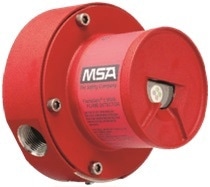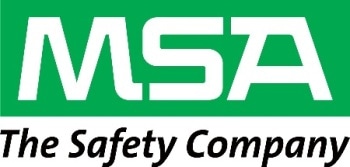LNG (liquefied natural gas) and CNG (compressed natural gas) are common methane fuels used by long haul trucking firms as well as municipal fleet vehicles, also known as NGVs (natural gas vehicles). Many companies are in the process of converting their fleets to running on LNG or CNG as opposed to diesel, due in part to the increasing accessibility of natural gas and rising diesel prices. This creates both a reduction in fuel costs and emissions.
As a result of this, NGV maintenance and storage facilities must be constructed, overhauled or renovated to include safety products which can monitor potential LNG/CNG leaks. These facilities tend to be large buildings, with ten or more bay doors, and roll-up doors for each bay.
CNG vehicles can be subject to leaks, arising because of premature gas cylinder release, often caused by using defective or incorrect pressure relief valves. It is also possible for the pressure relief valves on LNG vehicles to leak as well, particularly when they are stored in warm conditions. If these leaks occur in an enclosed space, for example where the NGVs have been stored in an enclosed maintenance facility, then these leaks can build up to hazardous levels. Such leaks, when a potential ignition source is introduced to the mix, can be the cause of explosions and fires.
The management personnel at such facilities must meet safety and building code monitoring requirements specific to the fuels in question to ensure a safe environment at such sites. In addition, such facilities may be located in public areas, an obvious concern for those working and living nearby.
Various trade associations, such as the National Fire Protection Association (NFPA) and the International Code Council (ICC), provide voluntary guidelines for the installation of the necessary gas detection instrumentation at NGV storage and maintenance facilities.
Specifically, NFPA 72: National Fire Alarm and Signaling Code 2013 Edition includes, “the application, installation, location, performance, inspection, testing, and maintenance of fire alarm systems, supervising station alarm systems, public emergency alarm reporting systems, fire warning equipment and emergency communications systems (ECS), and their components. “

However, local public safety requirements may stipulate the installation of both gas and flame detectors to address safety concerns via the Authority Having Jurisdiction (AHJ). According to the NFPA, “the AHJ may be a federal, state, local, or other regional department or individual such as a fire chief; fire marshal; chief of a fire prevention bureau, labor department, or health department; building official; electrical inspector; or others having statutory authority.”
In light of the activation of a gas detection system within a NGV maintenance or storage facility, the most common course of action is for the fire department to be notified, the bay doors to be opened, the heaters to be powered off and for the ventilation fans and louvers to be activated. In some cases, heating systems may deactivate as well. For this to happen, automated controllers are required to open the doors and activate or deactivate the fans and heaters. The reliability and accuracy, as well as the avoidance of false alarms, are crucial for the proper functioning of gas detection systems.
Solutions
MSA Ultima® X5000 XIR Plus Gas Monitors and FlameGard® 5 MSIR Flame Detectors meet the stringent requirements for LNG fueling station applications
The ULTIMA® X5000 Gas Monitor features a revolutionary design and touch-screen interface, along with dual sensing technology. Furthermore, it encompasses Bluetooth technology, thus providing real-time data at your fingertips. The XIR Plus detector makes use of innovative infrared technology to sense for combustible gases and vapors in order to rapidly and reliably detect LNG leaks.
The device is even able to compensate for the effects of temperature, humidity, and aging by making use of dual-wavelength heated optics technology. These monitors eliminate the need for gas calibration via simple zero adjustment. Ultima X5000 XIR Plus Gas Monitors consistently guarantee rapid response times and are immune to the effects of sensor poisoning.

Stainless steel explosion-proof design and an infrared source backed by a 10-year warranty and SIL 2 certification meets the requirements for a robust design. What’s more, simple maintenance is guaranteed through the use of single board design, an intuitive calibration process and field-swappable smart sensors.
As mentioned, false alarm rejection is the key to providing a reliable gas detection system. The FlameGard 5 MSIR Detector, with its four multi-spectrum infrared sensors and Neural Network Technology (NNT) are capable of distinguishing between fire and non-fire events at distances of as much as 230 feet. The reliability of the system is assured through the application of Continuous Optical Path Monitoring, which checks optical path integrity and the electronic circuitry of detectors. Dependability is enhanced by the ability to function at temperatures between -40 °F and 185 °F.
Furthermore, the wider field of view and longer range of these detectors means that fewer modules can cover a much greater range, thus cutting the costs for adequate protection. The strategic placement of the FlameGard 5 MSIR Detector facilitated by mounting brackets means a detector can cover the entire area around a tank.
- FlameGard 5 MSIR Detectors are SIL 3-certified.
- The line of sight of the FlameGard 5 MSIR Detector is able to penetrate through the dense smoke produced by diesel, rubber, plastics, lube oil and crude oil fires.
- Suitable in a variety of applications due to the multiple communication outputs.
- Serial communication port allows 128 units (247 using repeaters) to be linked to a host computer using Modbus RTU protocol.
- FlameGard 5 Test Lamp with high-energy broadband radiation source tests FlameGard 5 MSIR Detector operation.
- Easy output access is provided by a HART port.
- Optional mounting bracket enables detectors to be easily mounted within containment areas, and enables a single detector to cover the area around a tank.
- Patented sensor design offers sensor replacement without declassifying hazardous areas.
- Zero adjustment provides full calibration.
- Optional carbon dioxide detection is provided.

This information has been sourced, reviewed and adapted from materials provided by MSA - The Safety Company.
For more information on this source, please visit MSA - The Safety Company.